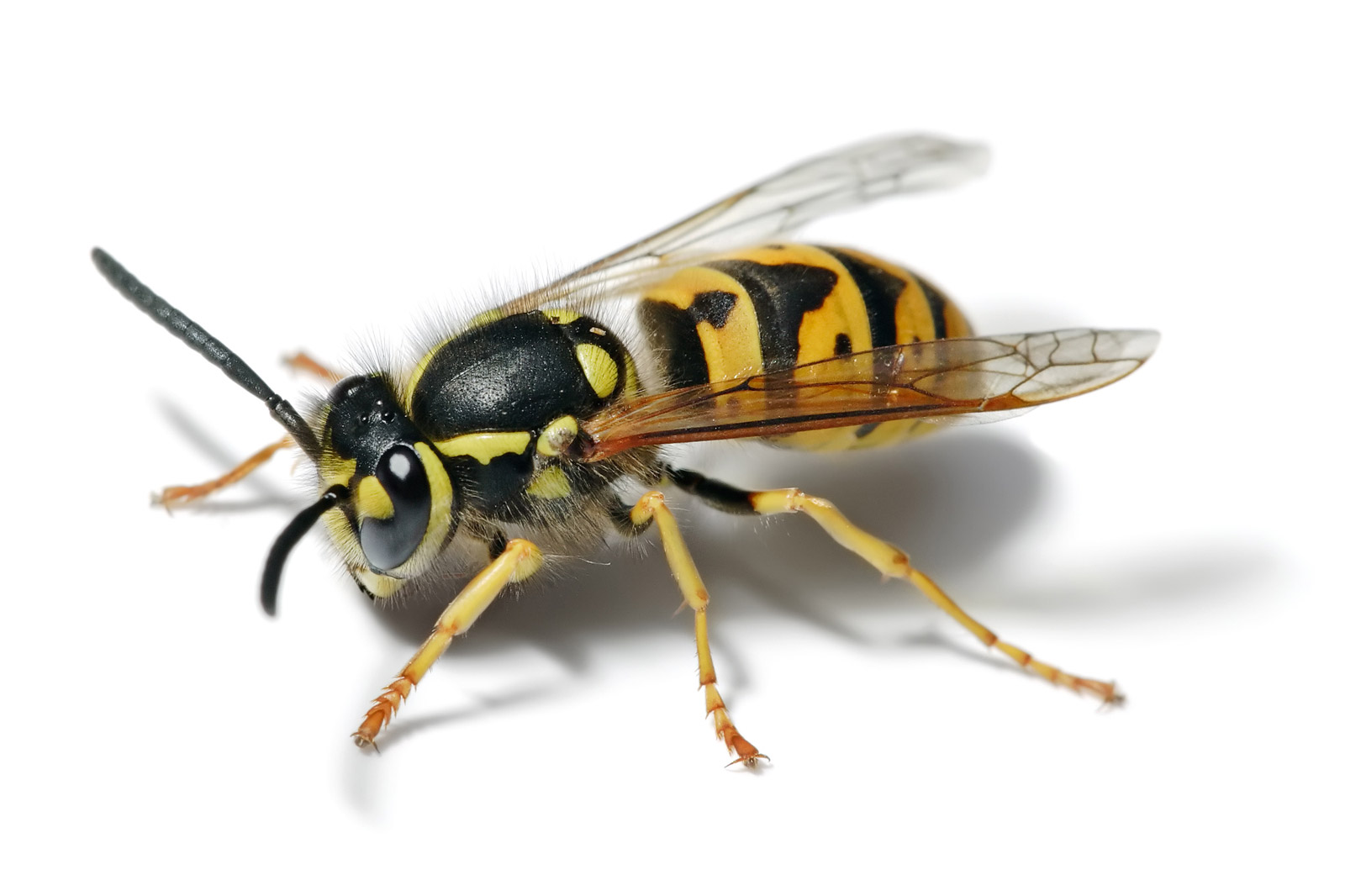- German wasp
image_width = 250px
image_caption = A German wasp
regnum =Animal ia
phylum =Arthropod a
classis =Insect a
ordo =Hymenoptera
subordo =Apocrita
familia =Vespidae
genus = "Vespula "
species = "V. germanica"
binomial = "Vespula germanica"
binomial_authority = (Fabricius, 1793)The German wasp, or European wasp, "Vespula germanica", is a
wasp found in much of theNorthern Hemisphere , native toEurope , northern Africa, and temperateAsia . It has been introduced and is well-established in many other places, includingNorth America ,South America (Argentina andChile ),Australia andNew Zealand . German wasps are part of the familyVespidae and are sometimes mistakenly referred to aspaper wasp s because they build a grey paper nest—although, strictly speaking, paper wasps are part of the subfamilyPolistinae . It is more commonly known in North America as ayellowjacket .Identification
The German wasp is about ½
inch (13 mm) long, and has typical wasp colours of black and yellow. It is very similar to thecommon wasp ("Vespula vulgaris"), but seen head on, its face has three tiny black dots. German wasps also have black dots on their abdomen, while the common wasp's analogous markings are fused with the black rings above them, forming a different pattern.Nests
The nest is made from chewed plant fibres, mixed with
saliva . They are generally found close to or in the ground, rather than higher up on bushes and trees likehornet s. It has open cells and a petiole attaching the nest to the substrate. The wasps produce a chemical which repelsant s, and secrete it around the base of this petiole in order to avoid antpredation .A solitary female queen starts the nest, building 20–30 cells before initial egg-laying. This phase begins in spring, depending on climatic conditions. She fashions a petiole and produces a single cell at the end of it. Six further cells are then added around this to produce the characteristic hexagonal shape of the nest cells.
Once the
larva e have hatched as workers, they take up most of the colony’s foraging, brood care and nest maintenance. A finished nest may be 20–30 cm across and contain 3,000 individuals.Each wasp colony includes one queen and a number of sterile workers. Colonies usually last only one year, all but the queen dying at the onset of winter. However, in mild climates such as New Zealand, around 10% of the colonies survive the winter. New queens and males (drones) are produced towards the end of the summer, and after mating, the queen overwinters in a crack or other sheltered location.
This common and widespread wasp collects
insect s includingcaterpillar s to feed to its larvae, and is therefore generally beneficial. The adults feed onnectar and sweet fruit, and are also attracted to human food and food waste, particularly sodas and meats.The nests are subject to predation by the
Honey Buzzard , which excavates them to obtain the larva. Thehoverfly "Volucella pellucens " and some of its relatives lay their eggs in the wasp's nest, and the larva feeds on the wasp's young.Pest status
This species is considered a pest in most areas outside its native range, though its long residency in
North America is such that it is not treated with any level of urgency there, in contrast to areas such as South America, where the introduction is more recent, and the impacts far more dramatic, prompting a greater degree of concern over control measures (e.g. [ [http://www.inta.gov.ar/bariloche/ssd/nqn/ecologiadeinsectos/pdfs/Sackmann%20et%20al%202001.pdf Successful Removal of German Yellow Jackets by Toxic Baiting] ] ).Along with the closely related
common wasp and two species of "Polistes ", the German wasp is likewise considered to be a pest in New Zealand. It was probably introduced in the late 19th century, but did not appear in large numbers until around 1940. [ [http://www.ebop.govt.nz/land/media/pdf/Fact_Sheet_PA03.pdf Pest Animal Control]Bay of Plenty environment report. Retrieved7 January 2007 ] It is common in the beech forest since it is one of the two wasps that feeds on the honeydew exuded by the nativebeech scale insect which lives in the bark of the trees. It has a serious effect on the forestecology since there is less honeydew available for the native birds. In domestic situations nests have been known to become very large, sometimes taking up entire attic spaces in houses. This is put down to the comparatively mild winters experienced in New Zealand, as opposed to the wasp's usual European habitat.Further reading
*cite journal| quotes=no|author=R. J. Harris, C. D. Thomas & H. Moller |year=1991 |title=The influence of habitat use and foraging on the replacement of one introduced wasp species by another in New Zealand |journal=
Ecological Entomology |volume=16 |issue=4 |pages=441–448 |doi=10.1111/j.1365-2311.1991.tb00237.xReferences
External links
* [http://ohioline.osu.edu/hyg-fact/2000/2075.html Ohio State University Yellowjacket fact sheet]
* [http://www.wvu.edu/~agexten/ipm/insects/hpm7002.pdf Differences between Yellowjackets and Hornets]
* [http://www.insektenflug.de Stunning photographs of Yellowjackets (and other insects) in flight]
Wikimedia Foundation. 2010.

